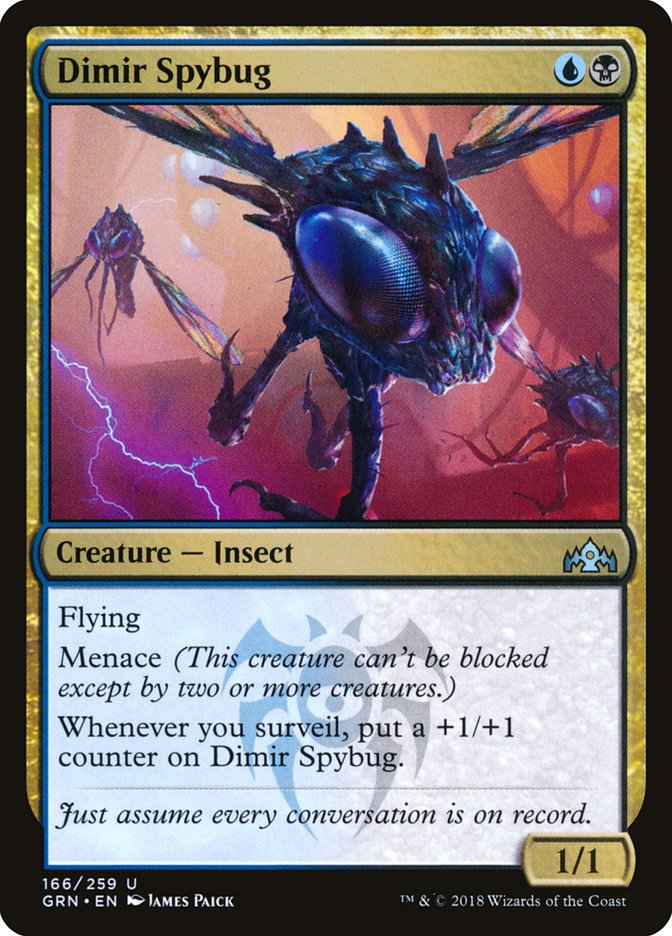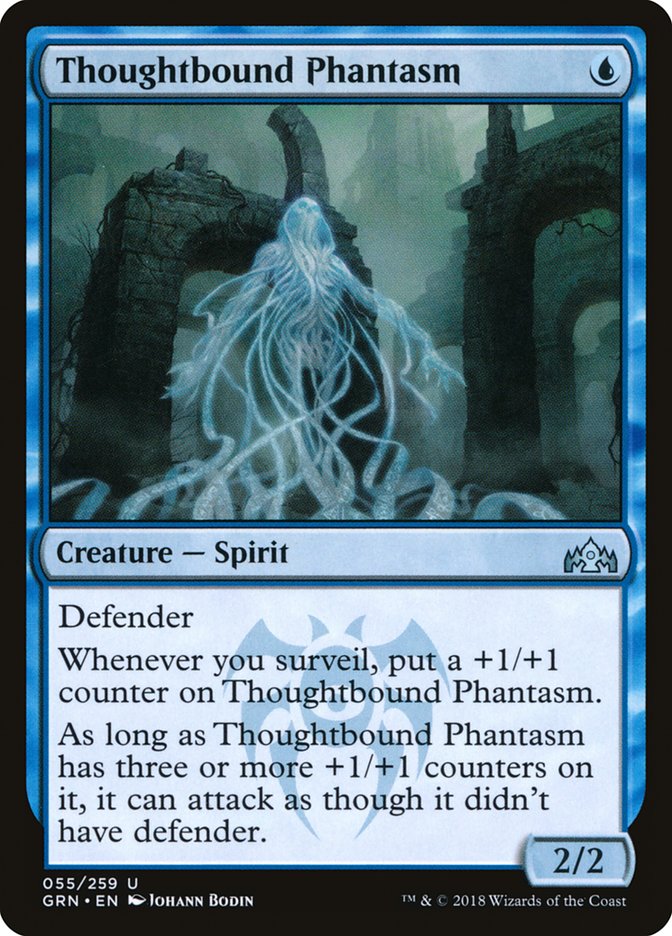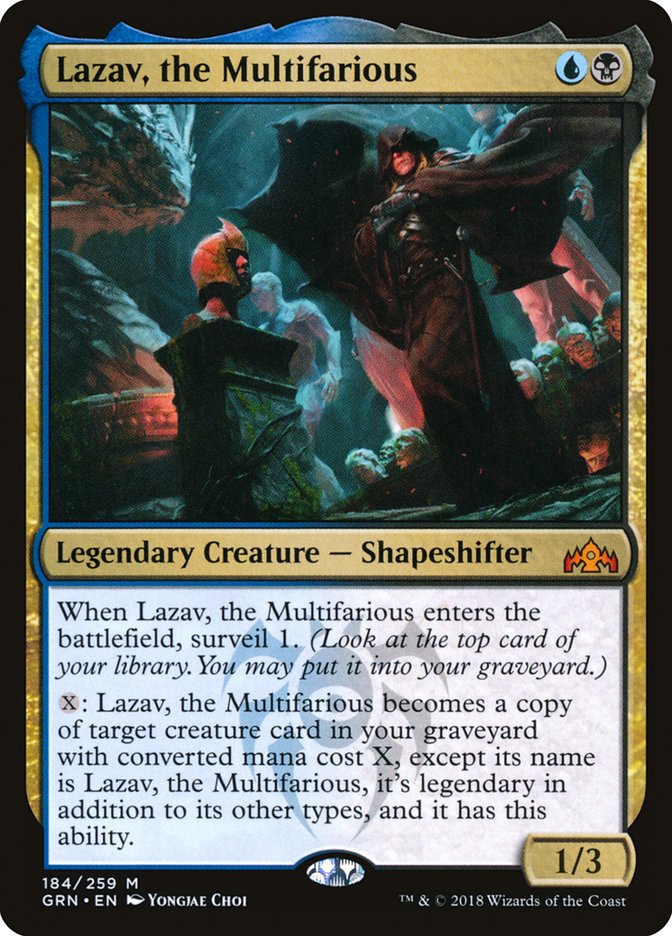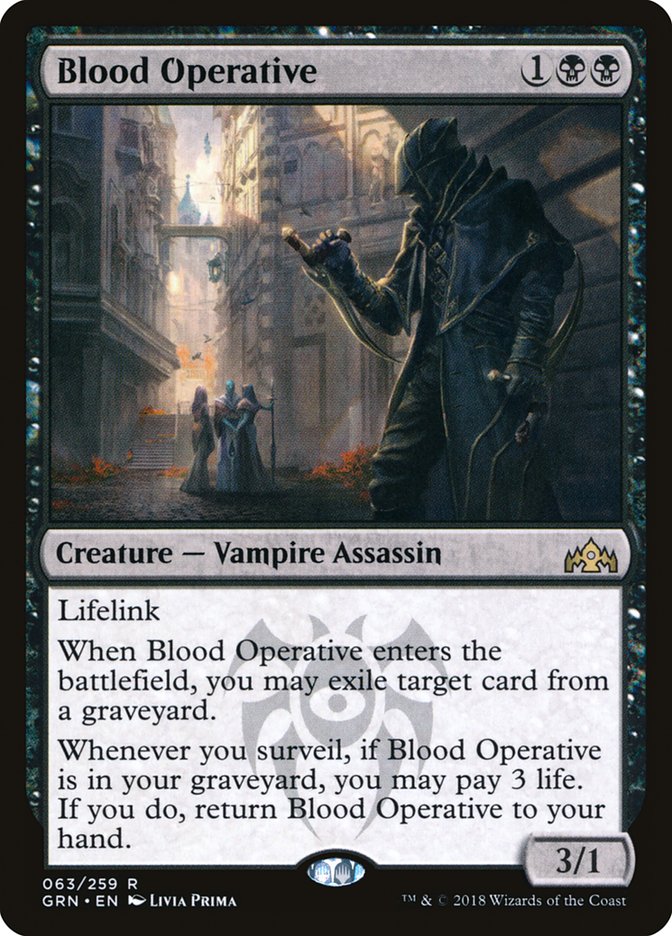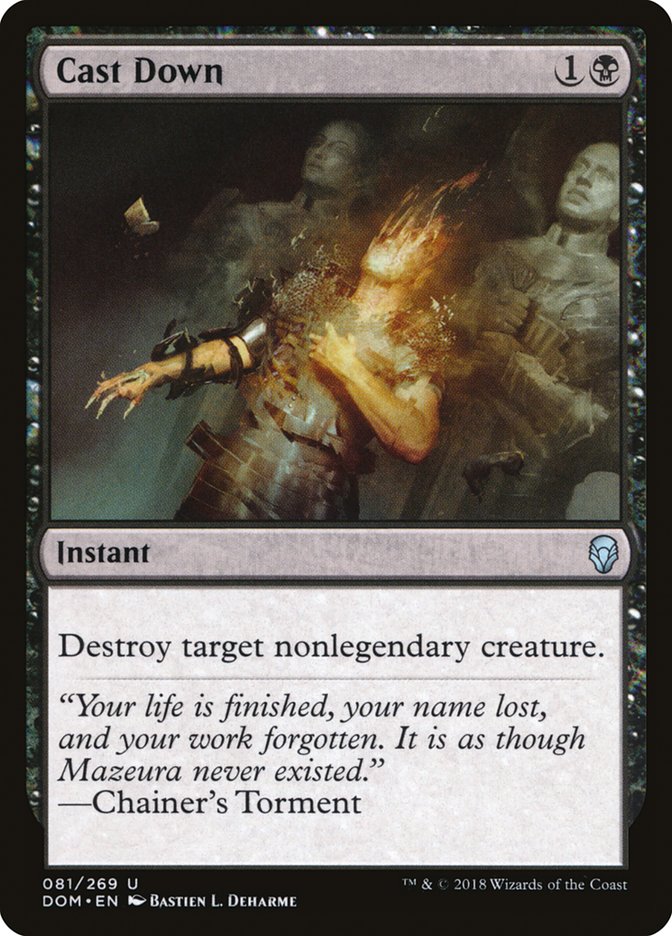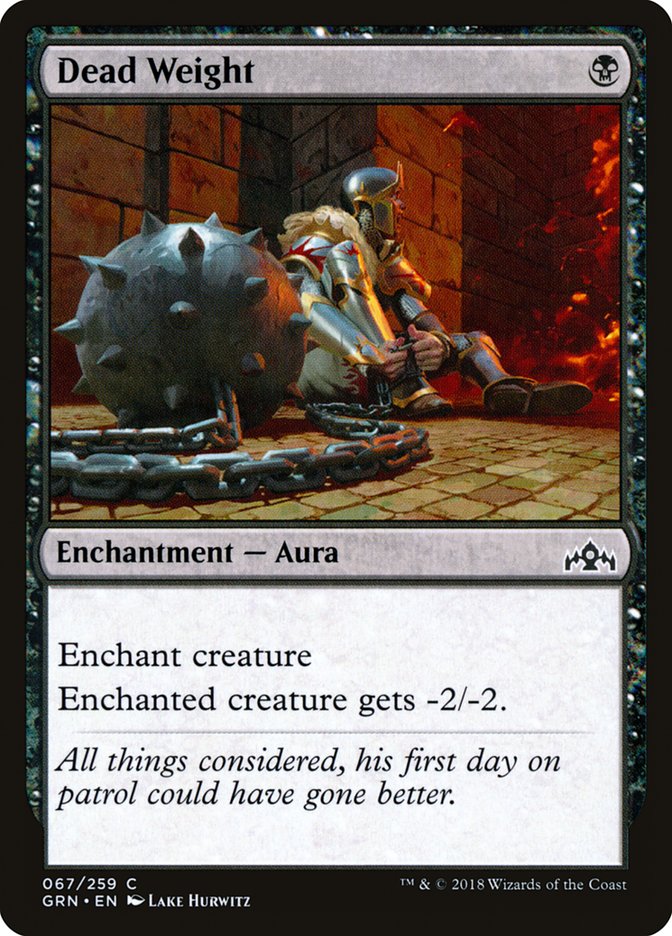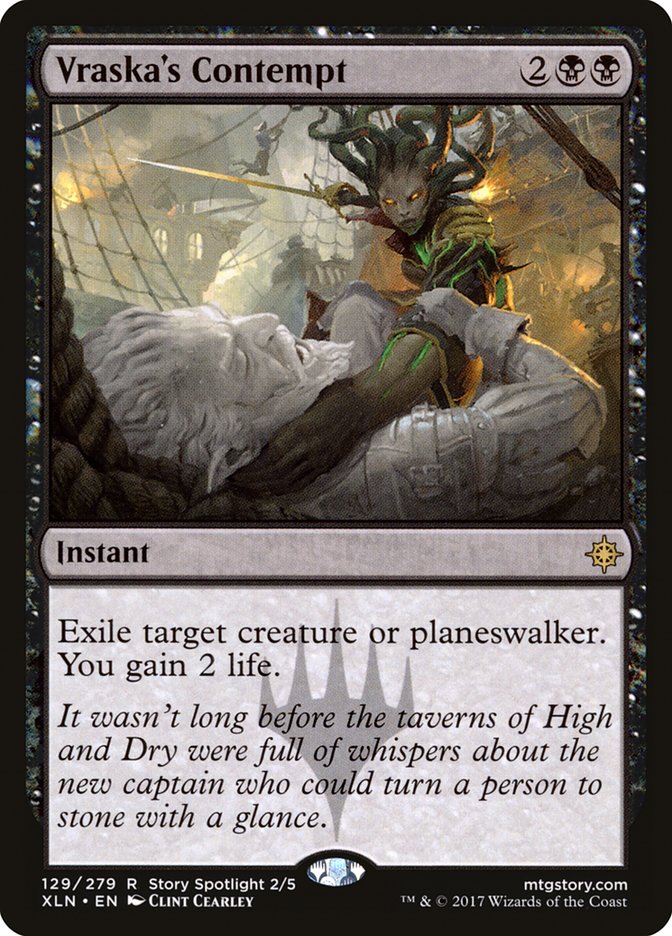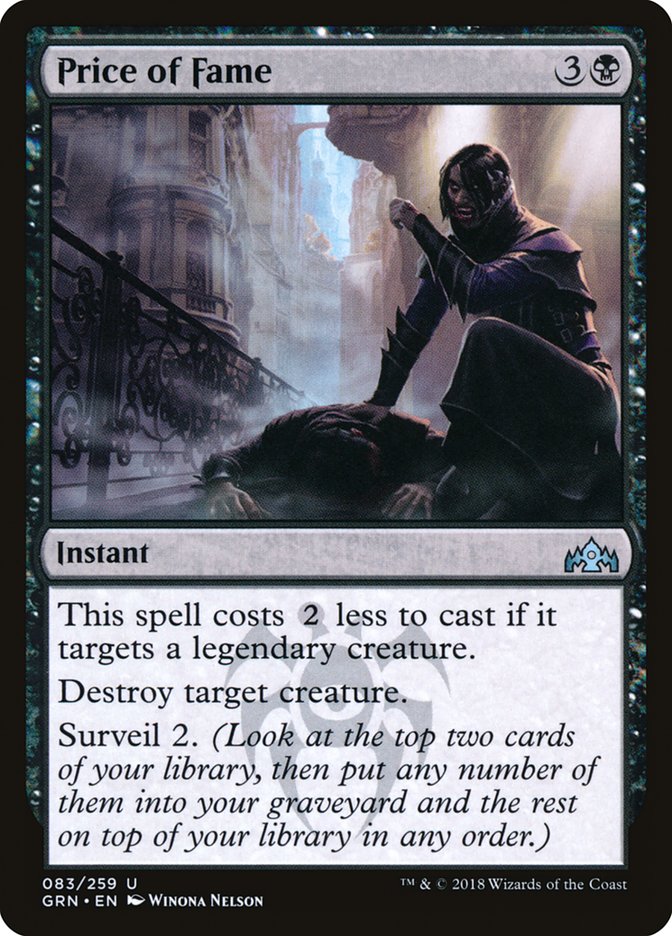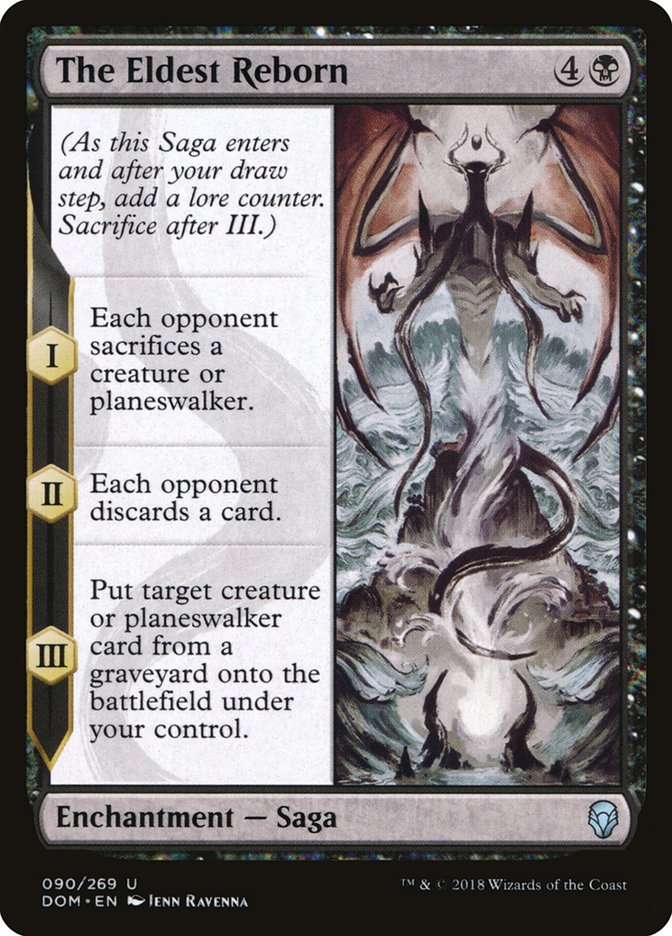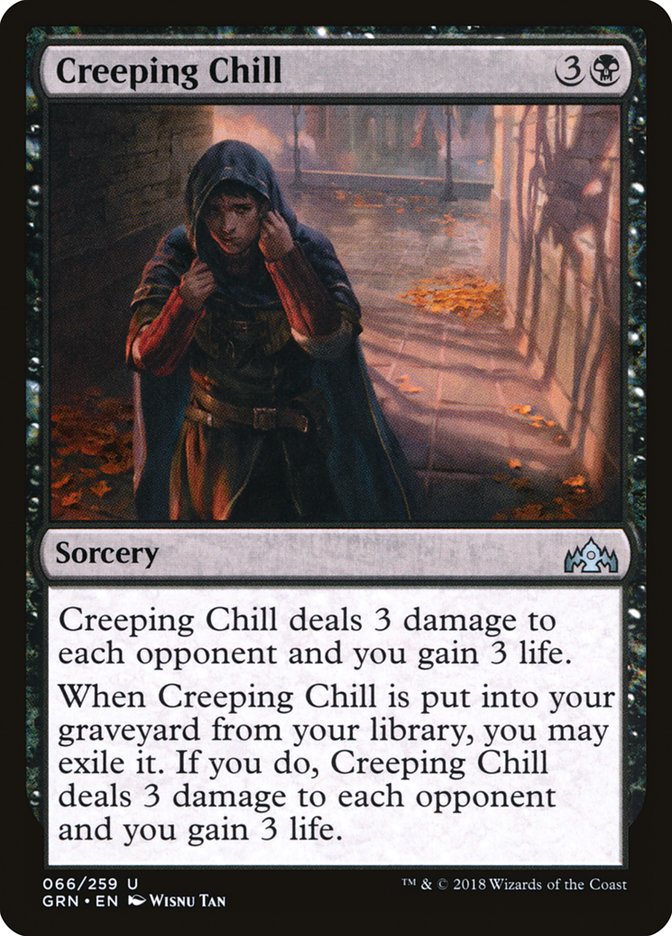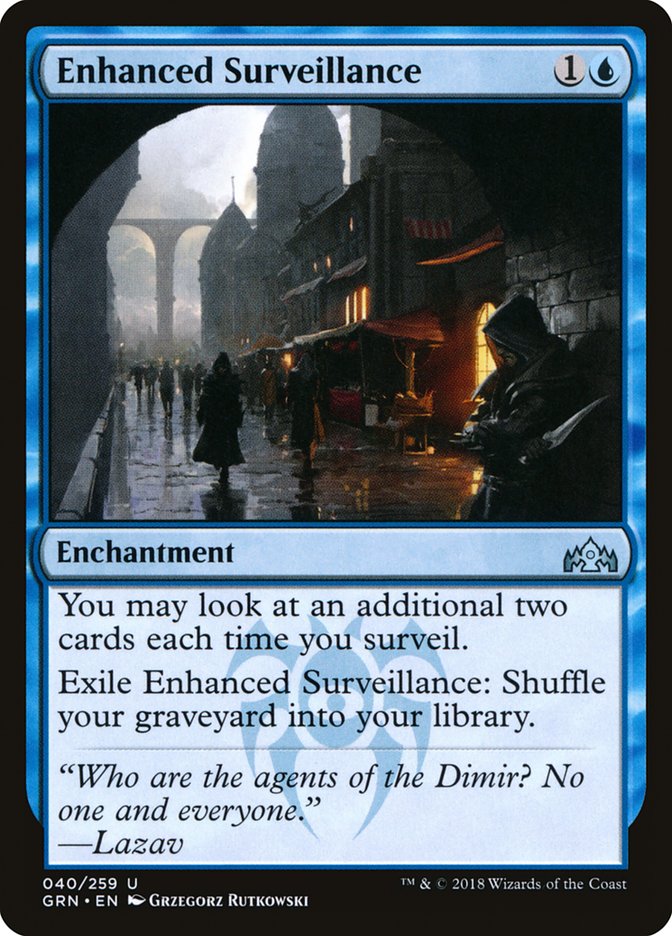I know why you’re here. You want some Guilds of Ravnica content.
Well, friends, I’m here to give it to you. This week, we’re going to be
focusing on the mechanic from the Dimir guild: surveil. We’ve already tried
a lot of Surveil cards on VS Live! where some have been hits and
others…not so much. But one thing looks pretty clear: Surveil is
effectively scry, except it helps fuel graveyard mechanics. But what we
haven’t really tried yet, until today, is a deck focusing on the cards that
get turbo-charged if you continually cast spells or use abilities that
surveil.
Willy Edel started it all. After
a cryptic tweet a few days ago
, I was inspired to go hard on the mechanic. Alongside Dimir Spybug,
something like Doom Whisperer could result in a combo-kill play where you
surveil until you hit one or two copies of Creeping Chill, which allows you
to surveil some more and ultimately attack for lethal with the Dimir
Spybug.
Yes, that does get blown out by a single spot removal spell. However, you
don’t really need to shove all-in unless your opponent is losing
the game that turn and they’re relatively low on mana or tapped out.
Instead, we can just small-ball them with cards like Notion Rain. And when
you start to play multiple creatures that get bigger as you surveil, things
start to get pretty scary.
One thing I learned from filming VS Live! yesterday was that both Dimir
Spybug and Thoughtbound Phantasm have some real power for a very small
investment. Thoughtbound Phantasm plays defense incredibly well while you
set up the rest of your turns. And when you surveil for the third time, it
starts getting in some serious damage. And while it isn’t exactly a big
tempo play, the turn where you start attacking with Thoughtbound Phantasm
is the turn where the game starts to shift in your favor.
What I was afraid of was not having enough cards that actually surveil, and
that my payoff creatures wouldn’t do enough to justify playing all these
cards. However, as the games played out, I found myself almost with an
abundance of surveil and not as many payoff cards as I would have liked.
Here’s the deck I played yesterday.
Creatures (19)
- 4 Nightveil Sprite
- 3 Doom Whisperer
- 4 Thoughtbound Phantasm
- 2 Lazav, the Multifarious
- 2 Blood Operative
- 4 Dimir Spybug
Lands (15)
Spells (26)
Sideboard

A few key notes before we do a deep-dive into the archetype.
-
It worked! Trying out a new mechanic or deck is usually a tough
process that involves dozens of iterations before you really “nail”
it. I don’t think I nailed this one down just yet, not even close,
but it’s rare that a deck just “does what it’s supposed to do” on
the first try. Everything that I wanted to happen did happen. Every
synergy that I expected to come up did come up! -
Doom Whisperer is a messed-up Magic card. Every time I cast the
card, it completely changed the shape of the game. Alongside Dimir
Spybug and Thoughtbound Phantasm, you get to turn the corner in an
instant at the low cost of some life and a free Demonic Tutor. My
next build will almost assuredly have four copies, though I’m
afraid drawing two will lead to some awkward early draws. -
Dimir Spybug and Thoughtbound Phantasm were important to play
early, but were still okay later in the game. Being cheap meant
casting them alongside one or two other spells on the same turn,
which let me keep casting removal or more threats as I drew cards
with Notion Rain or brought back Blood Operative. I rarely ran out
of cards, and when I did I usually had three or four major threats
already on the battlefield. -
Nightveil Sprite exceeded my expectations. Even though Ross killed
it most times it entered the battlefield, that means it was
powerful enough, or possibly scary enough of an engine, that it was
actually more important than my payoff cards. Like Mono-Blue
Devotion a few years ago, this deck is looking to play a few
low-powered cards in order to produce scary effects if they go
unchecked. And if the opponent must choose between killing the
engine or killing the payoff card, they’re almost certainly going
to choose killing the engine. And being a beacon for removal is
certainly powerful for a deck relying on drawing very specific
creatures in the early turns of the game. -
If my opponent isn’t playing removal, I think our threats and
synergy is powerful enough to race a lot of decks. Alongside cheap
removal like Dead Weight and Cast Down, I felt safe from potential
threats like Legion Warboss or other cheap creatures my opponent
could throw at me. While I ended up siding out all my removal in
that particular match against Ross, I think it’s important for a
deck like this to have that kind of interaction to buy enough time
for your engines and payoff cards to come online.
Now that we have that out of the way, let’s look at ways to potentially
change the deck for the better.
Lazav, the Multifarious is a great card when you start to combine it with
other cheap creatures that get put into the graveyard. And, if you have
enough mana, you can cast Lazav, the Multifarious and turn it into either
Dimir Spybug or Thoughtbound Phantasm with the surveil ability on the
stack, generating a +1/+1 counter. And, if you end up going late into the
game and end up with a ton of mana, turning Lazav into a Doom Whisperer is
awesome.
I’m not exactly sure if this card is worthwhile in the strategy. The fact
that it returns to your hand as opposed to the battlefield, as well as the
steep cost of three life, means Blood Operative is relatively slow. I also
found that it trades with virtually every creature your opponent puts in
front of it, which means the lifelink is essentially just paying for the
cost of re-casting Blood Operative. Unless you play a ton of removal, it’s
unlikely that Blood Operative will ever connect and actually gain you life.
Is Blood Operative a good Magic card? I certainly think so, but it
certainly isn’t a free-roll. I’ll have to think on this more.
I expect Spell Pierce will end up in my maindeck at some point. It just
feels so good to counter a big removal spell from the opponent, or even a
cheap removal spell in the early turns. And as the game progresses, cards
that would normally give you fits might be completely invalidated for a
single mana.
It’s also possible that, in a deck like this, Spell Pierce is just a worse
version of Dive Down, since protecting your creatures is what you want to
be doing more often than not with that particular slot. The tension comes
from wanting to spot very specific things, and we don’t have enough
information at this juncture to know if we should be trying to fend off
Ravenous Chupacabra or something like Cleansing Nova/Settle the Wreckage.
My gut is leaning toward the former, since Azorius doesn’t have Hallowed
Fountain or any new cards from Guilds of Ravnica.
This is the part of the deck I’m having the most trouble figuring out. As a
deck based around the surveil mechanic, it’s important to find a balance
between interaction, enablers, and payoff cards. If we have too many types
of any one aspect, there’s a chance we draw the wrong parts of our deck and
just get destroyed by a “good stuff” deck playing a bunch of more powerful
cards. After all, a draw featuring a bunch of Dimir Spybugs and
Thoughtbound Phantasms isn’t going to do much if we can’t turn them off.
Similarly, if we draw a bunch of Thought Erasure and Notion Rain without
any payoff, we’re just spinning our wheels.
But we also need to find a way to be interactive with our opponent in right
spots at the right times. Cheap removal like Dead Weight seems to fit
nicely, as it allows us to use all those extra cards we get from Notion
Rain. But as we get deeper into the game, finding an answer to a
Planeswalker is also equally important. In the past, decks like Turbo
Surveil have been incredibly difficult to construct because all the cards
look pretty bad on paper. It’s only when you start to see them all
interacting together do you really get a feel for what’s working and what
isn’t. And right now, I have no idea how good or bad the removal suite is
because the only matchup I’ve played is one where all my opponent’s
creatures were expendable.
Once we get a better idea of what the format has to offer and what decks we
need to come prepared for, we should be able to find the winning formula
for how this deck should be built. In the meantime, my gut is telling me
that Cast Down isn’t worthwhile, but Dead Weight is likely very good just
because it only costs one mana. I’m also going to keep two copies of
Vraska’s Contempt around for now, though it’s possible that we want more
tempo-oriented cards like Ravenous Chupacabra or even Exclusion Mage to
fill that role. And if we have creatures start to carry the heavy-lifting
of our spell-like effects, that means we could end up wanting more cards
that interact with our graveyard.
As for Price of Fame, I disregarded this card when I first saw it because
of the strict mana cost. However, as I play more with Turbo Surveil, it’s
clear that inefficient cards with surveil are generally better than they
look on paper. And while we don’t exile the creature and can’t get rid of
Planeswalkers, there’s a lot to be said about triggering all our creatures
with a removal spell attached. I’ve also found that the cost-reduction
comes up every now and then when dealing with stuff like Emmara, Soul of
the Accord. Long story short, Price of Fame is probably one mana too
expensive to be good, but that’s true for a lot of cards that “fill in the
gaps” for decks relying on synergistic effects.
This is certainly a card I want to get into the archetype. I think The
Eldest Reborn is one of the most powerful effects in the Standard format
and was a sideboard sleeper for a very long time in the previous Standard
format. As we got to the waning weeks and months, it was clear that most
decks with black mana in them should be playing at least one or two copies
of this card, if only in the sideboard.
And if we start to lean toward spell-like creatures ala Ravenous Chupacabra
or Exclusion Mage, The Eldest Reborn only gets better since we keep them
off-balance. They need to be trading via combat when possible, which means
the edict-effect can be backbreaking. And if we end up with a toolbox of
creatures to choose from once we fire off the third chapter, The Eldest
Reborn becomes a fix-it-all, especially so when we can choose to
continually surveil these types of creatures into our graveyard as the game
progresses.
Am I going too deep here? Can we really afford to play more five-drop cards
when I already cut a Doom Whisperer in the initial build? Well, at the very
least, it’s something we should consider. And if anything, it should be a
fantastic sideboard card against any non-token deck in Standard.
We still have a lot of stuff to try out when it comes to these new
mechanics and new decks. With that said, this is the version I’d like to
try out next.
Creatures (21)
- 2 Exclusion Mage
- 4 Nightveil Sprite
- 4 Doom Whisperer
- 4 Thoughtbound Phantasm
- 3 Lazav, the Multifarious
- 4 Dimir Spybug
Lands (14)
Spells (25)
Sideboard

All I want to do is play this new Standard format. Guilds of Ravnica has given me a shot in the arm and is looking to
produce one of the best Standard formats in recent memory. Of course, one
or two decks could ultimately sit on top of the format, and there are still
some really annoying cards we have to pay very close attention to. But when
a deck like Turbo Surveil can exist, and might actually be good,
it gives me hope for the future.
It’s no secret that the last few years of Standard have been…mediocre at
best. One or two best decks that fight for the title week after week? Cards
being banned every six or so months? We’ve definitely been through the
ringer as of late. But if I’ve learned anything from playing Magic over the
last decade and change, it’s that there always comes a time when the
pendulum swings in the other direction.
And hey, if it doesn’t, we still have Modern!
Before I sign off, I wanted to take a moment to talk about one card in
particular that has been getting some buzz when it comes to the surveil
mechanic, and one that I briefly mentioned before but didn’t do a deep dive
into.
When you go off with Dimir Spybug and Doom Whisperer, this is certainly a
card you want in your deck. After all, it gives you some much needed life
back while also fueling your “combo kill.” If you hit two copies of this
with both Dimir Spybug attacking and Doom Whisperer on the battlefield,
it’s enough to do lethal if you’ve attacked with Dimir Spybug at least one
time. That’s pretty scary by itself, but you also have to realize that
there’s a huge downside to playing cards like Creeping Chill in your deck.
Like Narcomoeba before it, actually drawing the card Creeping Chill is
downright embarrassing. And without Brainstorm to fix that problem and our
only real option for putting Chill back into our deck being Riverwise
Augur, you start to get a glimpse of the real problem. In order to play
Crippling Chill in our deck and have it be effective, we have to keep
lowering the overall power level of our deck to a point where I don’t feel
comfortable facing off against the likes of Rekindling Phoenix or Teferi,
Hero of Dominaria. Synergy will only get you so far.
But what I have been thinking about is a much more combo-oriented version
of this deck revolving around Enhanced Surveillance.
Hit a few Creeping Chills already? Or decided to discard one or two via
looting effects? Feel free to shuffle them back in. Additionally, we get to
surveil for two extra each time we use Doom Whisperer, which makes it more
likely that we actually find our Chills. Is this a good idea? I don’t
honestly know. But what I do know is that there are some pieces here that
are very curious, and the Dimir Guild is notoriously tough to figure out.
I’m likely grasping at straws here, but this interaction just feels a
little too convenient, and there’s a distinct possibility that someone way
smarter than me ends up figuring this out in the next few weeks, assembling
some easy combo kill that we all missed. Anyway, just something to think
about!
That’s all for me this week. And if you haven’t heard about it already,
we’ve been doing VS Live! for the last few weeks. And for the foreseeable
future, we’ll be doing them every Tuesday and Thursday over at twitch.tv/SCGTour at 1:00pm ET.
And if getting to see Guilds of Ravnica in action before the
Prerelease doesn’t strike your fancy, I don’t know what will. See you soon!


